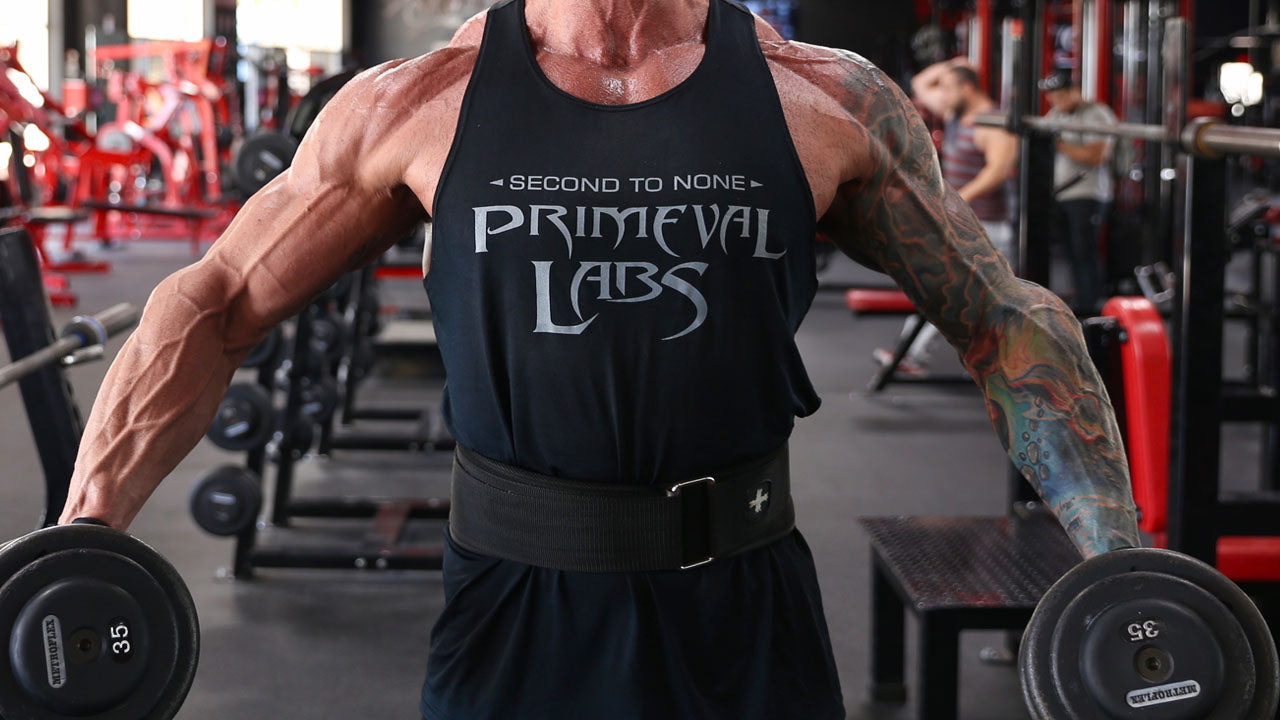If you’re reading this, you either:
- Love training legs, and are looking to bring even more pain and punishment to your lower body, or
- Avoid training legs, and finally, recognize the error of your ways.
Either way, we’ve got 5 quad-quaking options to intensify your leg workouts, spark new muscle growth, and make you rethink your sanity.
Let’s GO!
5 Workout Upgrades for Bigger Quads
1.5 reps
The 1-½ rep protocol has been around for years, and it’s pretty self-explanatory.
Let’s use the squat as an example.
Descend into the bottom of a squat, rise up halfway to full standing, then descend to the bottom again before finally standing all the way up.
Essentially, you “extend” every rep of every set by adding a “1/2 rep” in between each full-range of motion reps.
Perform full reps with partial reps between each.
The benefits of 1.5 rep sets are many:
- They increase the total time under tension and thus increase total work accomplished in a given training session.
- They can help address weak points in a lift or identify technical flaws by making your work longer in the harder ranges of motion of a given movement
- A fantastic way to make lighter weights “feel heavier”, which is helpful to those who may have a history of injury
- They build mental toughness. Don’t believe us? Just try doing a set of Bulgarian split squats using 1.5 rep technique.
21s
Any one who has ever performed a bicep curl has likely done a set of “21s.”
In case you have, a typical set of 21s involves performing:
- 7 reps from the bottom of the movement to the mid-way point
- 7 reps from the mid-point to the top, and
- 7 full range of motion reps
Now, just because 21s are most commonly used with curls, that doesn’t mean we can use the rep scheme for other exercises or muscle groups.
Seeing as the legs are one of the biggest muscle groups on the body, and the fact that they can respond very well to high rep sets (more on that next), 21s are an ideal option to incorporate into your training regimen.
Due to the intensity of this technique, we don’t recommend using it with barbell exercises. 21s are best reserved for dumbbells, kettlebells, or machines.
One of our favorite exercises to use the 21s technique is the hack squat.
Perform the first 7 reps of your 21-rep set from the hole to the midpoint. The next seven reps from the mid-point to the top. Finally, knock out 7 full range of motion reps.
100s
We all get stuck in our ways from time to time, especially when it comes to training.
Some lifters like to train with low reps and heavy weights (3-5 rep range), while others find better results training in more moderate rep ranges (8-10 or 12-15).
There’s nothing “wrong” per say with using these reps schemes in your training program. After all, these rep ranges are some of the most tried and true rep schemes for building muscle and strength.
At the same time, there’s equally nothing “wrong” with training outside of these rep schemes.
That’s where 100 rep sets come into play.
The name says it all.
You pick an exercise and start banging out reps (using good form and control, obviously), with the aim being to complete all 100 reps.
Now, you won’t (or shouldn’t) be able to get all 100 reps completed without taking a break. If you did, you selected the wrong weight.
Pick a weight that you can lift for 20 reps, and start repping out. When you feel like you might fail on the next rep, pause, and take 5-10 breaths, and then get back at it.
Continue in this rest-pause fashion until all 100 reps are complete.
Do not rack the weight until all 100 reps are complete.
Write down how long it took you to perform all 100 reps.
Then, the following workout, aim to complete your 100 reps faster than the previous week (while still using good technique and controlling the weight up and down).
When you can complete all 100 reps in less than 5 minutes, bump up the weight by 5 pounds and start over again.
Note: 100 rep sets are highly fatiguing and work best with machine or isolation exercises. It is NOT recommended to do 100s with barbell exercises. Due to the extreme mental and physical taxation “100s” place on the body, it’s advised to place your 100 set at the end of your workout as a “finisher”.
Some of our favorite 100-rep options for legs are leg press, sissy squats, and leg extensions.
2-Minute Leg Press
For each rep, extend your legs to 95% of lockout. Again, the key is to keep the tension on the muscle at all times.
As much flack as machines get from some in the fitness community, when it comes to building lower body muscle, they can be an incredibly effective addition to complement your weekly squatting and lunging.
And the “king” of leg machines is the leg press.
This versatile piece of equipment hammers the entire lower body and with just a small adjustment of your feet, you can emphasize different regions of your thighs.
Want to hit the quads?
Keep your feet closer together and in-between the middle and bottom of the platform.
Want to emphasize the hamstrings, adductors, and/or glutes?
Place your feet higher on the sled and use a wider stance.
The other great benefit of the leg press is that it allows you to go heavy and do high reps, without worrying about straining your lower back (as would be the case when doing heavy barbell squats).
The two-minute leg press is pretty simple.
Set a timer for two minutes and start performing smooth, controlled reps on the leg press using a full range of motion. In this case “full range of motion” means lowering the sled until your quads cover your chest. As you press the weight back up, extend your legs until just short of lockout, which maintains tension on the quads the entire time.
Your goal is to perform continuous reps for the entire two minutes. If you do need to pause, you can briefly rest (a la rest-pause), but do NOT rack the weight. The goal of these two-minute work sets is to keep constant tension on the quads which drives more blood and nutrients into the quads, delivering one hell of a lower body muscle pump.
We suggest beginning with a weight that you can comfortably press for 20 high-quality reps, and then cutting that weight in half for your 2-minute leg press.
Note, you do NOT rack the weight (sled) at any point during the 2-minute work period.
2-minute leg presses work phenomenally well as a primer or pre-fatiguing movement for the legs.
After completing a 2-minute leg press at the start of your workout, you can move onto the rest of your workout, where’ll you’ll be able to fatigue your muscles with less weight than if you’d started out with squats.
This is ideal for individuals with a history of injuries, as well as those who aren’t built to squat with a barbell on their back.
The 2-minute leg press can also be used as a finisher at the end of your workout for those of you looking to finish off your quads with 2 minutes of hell.
Heels Elevated Goblet Squat/Lunge Superset
Hate doing cardio?
You’re not alone.
The good news is that if you survive this superset you’ll have knocked out your resistance-training and cardio workouts in one fell swoop!
Grab a heavy dumbbell or kettlebell and elevate your heels on a step or put a 5-10# plate under each heel. This elevation decreases the range of motion at the hip and increases the range of motion at the knee, which shifts more tension onto the quads.
Additionally, holding the weight in front of your body also helps emphasize the quads more as you’ll have to maintain a more vertical torso compared to squatting with a bar on your back.
Squat as deep as you can and drive up to a standing position for 20 reps.
As soon as you finish your set of squats, drop the ‘bell and immediately start doing walking lunges.
You don’t need to worry about weight here as your quads will already be burning from the goblet squats.
Perform 20 lunges per leg.
If you feel that you might fail at any point, briefly pause (i.e. rest-pause) and then continue until you’ve completed 20 lunges with each leg.
After this superset is done, crawl to the corner and be prepared to seriously question your sanity.
Perform this superset for 2-3 rounds resting 2 minutes between efforts.















Leave a comment
This site is protected by hCaptcha and the hCaptcha Privacy Policy and Terms of Service apply.